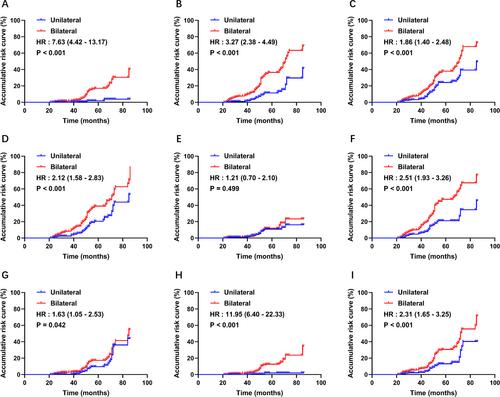Risk factors investigation for different outcomes between unilateral and bilateral chronic rhinosinusitis with nasal polyps patients
Abstract
Background
Studies involving chronic rhinosinusitis with nasal polyps (CRSwNP) have mostly focused on bilateral cases, making unilateral CRSwNP inadequately recognized. This study examined the differences in clinical characteristics, outcomes, and risk factors for poor outcomes between unilateral and bilateral CRSwNP to facilitate a better assessment in the two groups.
Methods
Demographic information, tissue and blood cells, endoscopic scores, Lund-Mackay scores, recurrence rates, and disease control conditions were compared between 310 unilateral and 596 bilateral CRSwNP patients. Furthermore, the stepwise regression multivariate Cox proportional hazard models were performed to generate risk factors for poor outcomes in the two groups.
Results
Bilateral cases exhibited higher rates of smoking, AR, and asthma comorbidities, along with higher numbers of tissue eosinophils and blood inflammatory cells when compared to unilateral patients. Endoscopic nasal polyp score, total computed tomography (CT) score (with scores for each sinus cavity), and adjusted CT scores were significantly higher in the bilateral group, except for a markedly higher adjusted maxillary score in the unilateral group. Furthermore, significantly higher proportions of bilateral patients experienced nasal polyp recurrence, uncontrolled status, and most disease control-related symptoms at follow-up. The primary risk factors for poor outcomes were asthma, tissue eosinophils, and total CT score in the bilateral group and blood basophils in the unilateral group.
Conclusions
Bilateral CRSwNP patients experience worse disease severity and outcomes than their unilateral counterparts. Primarily, asthma, tissue eosinophils, and total CT score were risk factors for poor outcomes in bilateral CRSwNP patients, with blood basophils in unilateral cases.


 求助内容:
求助内容: 应助结果提醒方式:
应助结果提醒方式:


